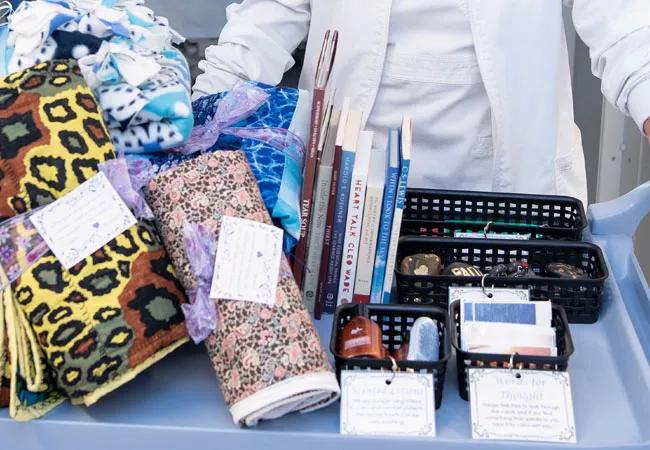Advertisement
Initiatives include comfort carts and the Pause

After Cleveland Clinic Avon Hospital opened in 2016, its staff of seasoned nurses began noticing something different from their previous hospitals. Because of the community’s older population and numerous skilled nursing facilities, Avon Hospital was caring for more patients at the end of life.
Advertisement
Cleveland Clinic is a non-profit academic medical center. Advertising on our site helps support our mission. We do not endorse non-Cleveland Clinic products or services. Policy
Death and dying was a recurring phenomenon — particularly in the ICU setting, where Cheryl Mooney, RN, set out to enhance care for end-of-life patients and their families. Inspired by an article that featured hospital staff who presented blankets to grieving families, Mooney envisioned a whole cart of comforting items.
Avon Hospital’s nursing leaders encouraged Mooney to recruit members of the ICU Shared Governance team to make her cart a reality. The comfort cart rolled out in Avon Hospital’s ICU in early 2018.
In addition to beverages and snacks found on standard “bereavement carts,” Avon Hospital’s comfort cart offers items of support donated by community groups and staff, including:
“Before comfort carts, nurses would provide support, but we had nothing tangible for comforting families,” explains Sara Novicky, BSN, RN, Nurse Manager, Critical Care and Step Down.
The effect of the comfort cart has been powerful.
Novicky remembers the daughter of one patient who, as a child, had collected rocks and proudly presented them to her parents. As an adult, when her father was removed from life support, she took meditation stones from the comfort cart and laid them on his chest. The symbolic gesture was moving for the family as well as the caregivers present.
“The cart and its contents have eased the spiritual and emotional adjustment associated with imminent death for everyone involved, including nurses,” says Jacquie Nowlin, DNP, MBA, RN, NEA-BC, Director of Nursing, Acute and Critical Care Services at Avon Hospital.
After testing the comfort cart, Mooney and her team applied for and received a grant to replenish the cart and to buy carts for other units, including Avon Hospital’s Emergency Department.
“Historically, in a critical care environment, providers were trained to accelerate treatments (to do everything possible) to maintain life of clients,” says the hospital’s Chief Nursing Officer Mary Sauer, DNP, MBA, RN, NEA-BC. “Comfort carts offer a different type of patient- and family-centered care and attempt to lessen the mental anguish and fatigue that are prevalent in a critically charged, fast-pace environment.”
Advertisement
Cleveland Clinic also introduced another innovation in end-of-life care. “The Pause” — a moment of silence and the reading of a special script at the bedside of a patient who has died — to honor a patients’ life and journey and recognize the efforts of caregivers.
The concept was developed at the University of Virginia Medical Center and was introduced to Cleveland Clinic clinicians and providers through a Cardiology Fellow in the Coronary ICU.
“I was amazed by how powerful it was for me as a caregiver,” says Clinical Nurse Specialist Debbie Klein, MSN, APRN, ACNS-BC. “It gave me time to honor the person who had just died.”
Klein became passionate about instituting The Pause throughout Cleveland Clinic and now co-chairs the Center for End-of-Life Care Pause Committee.
“Treating patients in their last hours can be an intense experience,” she says. “We need to remember to take care of ourselves as well as the patients in our care.”
Although designed for caregivers, the patient’s family and loved ones are invited to participate in The Pause. Participation is voluntary for everyone and occurs as soon as possible after the time of death.
A physician or nurse leads The Pause with this suggested script:
“Let us take a moment to pause and honor [patient’s name]. He/she was someone who loved and was loved — was someone’s family member and friend. In our own way and in silence, let us take a moment to honor [patient’s name]. Let us also honor and recognize the care provided by our team.”
[15–30 seconds of silence]
“Thank you, everyone.”
Cleveland Clinic is in the process of placing cards with The Pause suggested script on all emergency carts in the health system. Cards are available in English, Spanish, Arabic, Russian, Mandarin and Cantonese.
Donielle Finding, MSN, MBA, RN, Assistant Nursing Director at Cleveland Clinic Medina Hospital, says The Pause provides closure, giving caregivers a moment to collect themselves before walking into another patient’s room.
“So often, nurses’ interactions at the bedside become routine. But a death should never be routine,” says Novicky.
“Nurses may not realize the burden they carry when witnessing a patient’s death,” she says. “We used to just go about our business, but now comfort carts and The Pause are helping us cope in a healthier way.”
Advertisement
Advertisement

Education, training and reporting can help reduce workplace violence in healthcare

Wound, ostomy and continence nurses provide skin assessments, wound prevention measures, treatment and education

Virtual model enables around-the-clock management of common acute conditions

Resources, education, mentoring help nurses segue to formal leadership roles

Holistic nurses work across all nursing specialties to support patients and caregivers

Nurses play pivotal role in patients’ ability to recover in the comfort of their own homes

Advocating for patient safety is imperative in fast-paced surgical settings

Advice for those pursuing a WOC nursing career